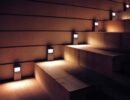This article provides 12 ways you can save energy while lighting the home, with tips for efficient fixture placement and techniques to avoid wasting energy.
At the risk of stating the obvious, converting your incandescent light bulbs to compact fluorescent bulbs (seeenergy-efficient light bulb) is critical to saving money on your light bills. But let’s move the conversation beyond that. Here are a few other helpful techniques you can draw upon.
1Turn off lights that aren’t being used

Okay, YES, this is another obvious one. Could anything be easier than flipping a light switch? This is the simplest, most common-sense solution, which can result in surprisingly significant energy savings. Consider that a 75-watt light bulb left on for a couple hours daily can comprise up to 2 percent of your overall monthly lighting bill. Make it a habit to always shut off the lights when you leave a room.
2Be sure to dust
You might as well get the most light possible out of a bulb—a layer of dust is going to cut down on the light it offers. A dusty bulb is an inefficient bulb. Get out the dust rag, and get your money’s worth from your lighting.
3Use task lighting
Just use light where you need it. Don’t flood an entire room with light when all you need is a small reading lamp. Choose lighting that meets your specific functional needs. Bedside lights, reading lamps, under-cabinet lights, and desk lights are just a few examples of good task lighting.
4Place lamps in corners
Take advantage of walls as reflective surfaces. Placing lamps in corners allows light to bounce off two wall surfaces, meaning you will need fewer lights overall.
5Choose light colors when painting your walls

Light reflects off pale tones more easily than it does off dark shades, allowing you to use lower-wattage light bulbs in your home. Where glare isn’t a problem, consider paints that have high reflective values.
6Use daylighting techniques
This is the practice of using natural light for illumination. Enhancing your home’s daylighting can mean everything from simply moving your desks and work surfaces closer to sunny windows to installing new skylights. SeeDaylighting Techniquesfor more on these methods.
7Use automatic timers and/or dimmers
Timers, which regulate electrical usage by turning on and shutting off lighting sources at set times, and dimmers, which allow you to modulate the brightness of a lighting source, can contribute greatly to energy savings. For more on these, seeLight Switch OptionsandLighting Dimmer Switches.
8Don’t neglect outdoor lighting
Choosing Energy Saving Light Bulbs
When it comes time to change that light bulb, you can make a “green” choice—one that will save both energy and money. Here are some suggestions:
9Choose LED or compact fluorescent lamps (CFLs).Compact fluorescents use from about one quarter to one third as much energy to produce the same amount of light as a standard incandescent bulb, and they can last up to thirteen times longer. LEDs also save a great deal of electricity and last for decades.

CFL torchieres are also available to replace those energy-hogging halogen versions that gained popularity in the 1990s. For more on CFLs, seeCompact Fluorescent Lighting.
10Purchase three-way bulbs.Three-way bulbs can operate at three different wattages (for instance, 50 watts, 100 watts, and 150 watts), allowing you to choose the lowest wattage for your needs. They work on lamps outfitted with three-way sockets. Both CFL and incandescent varieties are available.
11Choose low-wattage bulbs.总是使用最低的功率会满足你的needs. Try out bulbs of varying brightness, measured in lumens, to find the least energy-sucking bulb for your particular lighting application.
12Select energy-saving nightlights.Replace incandescent nightlights with plug-in electroluminescent panels, which consume a mere 3/100 watt of electricity, or the brighter mini-fluorescent varieties, which give off as much illumination as a 20-watt standard bulb. In addition, photocell nightlights sense the presence of light in a room, automatically turning on at night and off in the daytime.
Outside lights are often left on unnecessarily. Using things such as timers, motion or photoelectric sensors, or solar power with your exterior lighting setup can be helpful. For more, seeEnergy-Efficient Outdoor Lighting.







 Don Vandervort writes or edits every article at HomeTips. Don has:
Don Vandervort writes or edits every article at HomeTips. Don has: